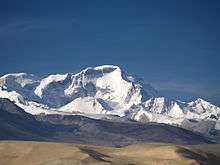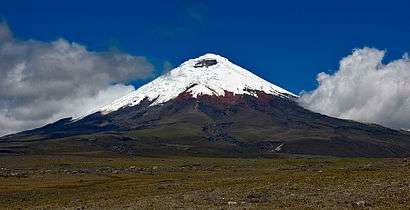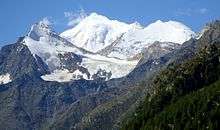Snow line
The climatic snow line is the point above which snow and ice cover the ground throughout the year. The actual snow line may seasonally be significantly lower.
Background
The interplay of altitude and latitude affects the precise placement of the snow line at a particular location. At or near the equator, it is typically situated at approximately 4,500 meters (or about 15,000 feet) above sea level. As one moves towards the Tropic of Cancer and Tropic of Capricorn, the parameter at first increases: in the Himalayas the permanent snow line can be as high as 5,700 metres (18,700 feet), whilst on the Tropic of Capricorn no permanent snow exists at all in the Andes because of the extreme aridity. Beyond the Tropics the snow line becomes progressively lower as the latitude increases, to just below 3,000 metres in the Alps and falling all the way to sea level itself at the ice caps near the poles.
In addition, the relative location to the nearest coastline can influence the altitude of the snow line. Areas near a coast might have a lower snow line than areas of the same altitude and latitude situated in a landmass interior due to more winter snowfall and because the average summer temperature of the surrounding lowlands would be warmer away from the sea. (This applies even in the tropics, since areas far from the sea will have larger diurnal temperature ranges and potentially less moisture, as observed with Kilimanjaro and presently glacier-free Mount Meru). A higher altitude is therefore necessary to lower the temperature further against the surroundings and keep the snow from melting.
Furthermore, large-scale oceanic currents such as the North Atlantic Current can have significant affects over large areas (in this case warming northern Europe, extending even to some Arctic Ocean regions).
Records
The highest mountain in the world below the snow line is Ojos del Salado.[2]
Approximate levels
| Svalbard | 78°N | 300–600 m |
| Scandinavia at the polar circle | 67°N | 1000–1500 m |
| Iceland | 65°N | 700–1100 m |
| Eastern Siberia | 63°N | 2300–2800 m |
| southern Scandinavia | 62°N | 1200–2200 m |
| Alaska Panhandle | 58°N | 1000–1500 m |
| Kamchatka (coastal) | 55°N | 700–1500 m |
| Kamchatka (interior) | 55°N | 2000–2800 m |
| Alps (northern slopes) | 48°N | 2500–2800 m |
| Central Alps | 47°N | 2900–3200 m |
| Alps (southern slopes) | 46°N | 2700–2800 m |
| Pyrenees | 43°N | 2600–2900 m |
| Corsica | 43°N | 2600–2700 m |
| Caucasus | 43°N | 2700–3800 m |
| Pontic Mountains | 42°N | 3800–4300 m |
| Rocky Mountains | 40°N | 2100-3,350 m |
| Karakoram | 36°N | 5400–5800 m |
| Transhimalaya | 32°N | 6300–6500 m |
| Himalaya | 28°N | 6000 m |
| Pico de Orizaba | 19°N | 5000–5100 m |
| Rwenzori Mountains | 1°N | 4700–4800 m |
| Mount Kenya | 0° | 4600–4700 m |
| New Guinea | 2°S | 4600–4700 m |
| Andes in Ecuador | 2°S | 4800–5000 m |
| Kilimanjaro | 3°S | 5500–5600 m |
| Andes in Bolivia | 18°S | 6000–6500 m |
| Andes in Chile | 30°S | 5800–6500 m |
| North Island, New Zealand | 37°S | 2500–2700 m |
| South Island, New Zealand | 43°S | 1600–2700 m |
| Tierra del Fuego | 54°S | 800–1300 m |
| Antarctica | 70°S | 0–400 m |
Compare the usage of "snow line" indicating the boundary between snow and non-snow.[3]
See also
References
- Charlesworth J.K. (1957). The quaternary era. With special reference to its glaciation, vol. I. London, Edward Arnold (publishers) Ltd, 700 pp.
- Flint, R. F. (1957). Glacial and Pleistocene geology. John Wiley & Sons, Inc., New York, xiii+553+555 pp.
- Kalesnik, S.V. (1939). Obshchaya glyatsiologiya [General glaciology]. Uchpedgiz, Leningrad, 328 pp. (in Russian)
- Tronov, M.V. (1956). Voprosy svyazi mezhdu klimatom i oledeneniem [The problems of the connection between climate and glaciation]. Izdatel'stvo Tomskogo Universiteta, Tomsk, 202 pp. (in Russian)
- Wilhelm, F. (1975). Schnee- und Gletscherkunde [Snow- and glaciers study], De Gruyter, Berlin, 414 pp. (in German)
Footnotes
- ↑ Approximations. Snow line elevations retrieved from Google Earth on 2014-08-20
- ↑ Regional Climate and Snow/Glacier Distribution in Southern Upper Atacama (Ojos del Salado) - an integrated statistical, GIS and RS based approach
- ↑ Adam, Steve; Alain Pietroniro; Melinda M. Brugman (1997). "Glacier Snow Line Mapping Using ERS-1 SAR Imagery" (PDF). Remote Sensing of Environment. New York: Elsevier Science Inc. 61 (1): 46–54. doi:10.1016/S0034-4257(96)00239-8. Retrieved 2010-09-28.
The snow line at the end of the ablation season is roughly equal to the equilibrium line altitude (ELA) for temperate glaciers


